The King James Version with Strong's Links (KJVSL) is a special Bible module in SwordSearcher that includes links to Strong's definitions of Hebrew and Greek root word forms in the text. The KJVSL is searchable by Strong's numbers as well.
The explanation of the KJVSL also applies to the Spanish module SRVSL.
To view the KJVSL, click the KJVSL tab in the Bible panel, or select it on the Bible menu.
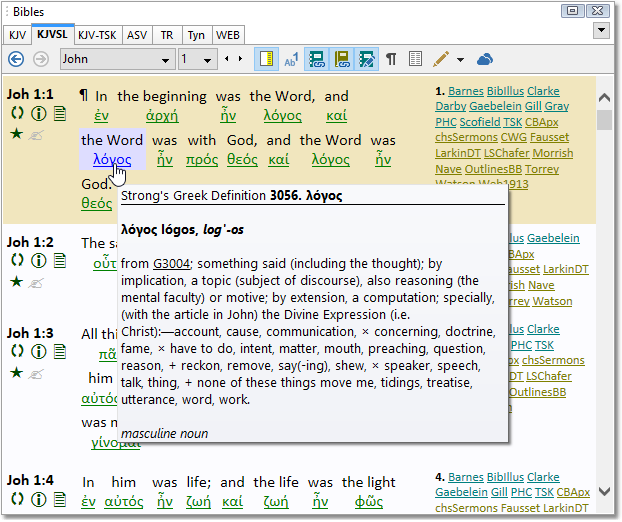
Sample of the KJVSL Bible module, showing pop-up Strong's definition
Holding the mouse pointer over a Greek or Hebrew link will pop-up the Strong's definition of that word. You can click on the link to be taken directly to that entry in the corresponding lexicon in the Book panel.
The above pictures shows the reverse interlinear format of the KJVSL. You can change to in-line display under Bible and Verse List Panels: Additional Options settings. The in-line display looks like this:
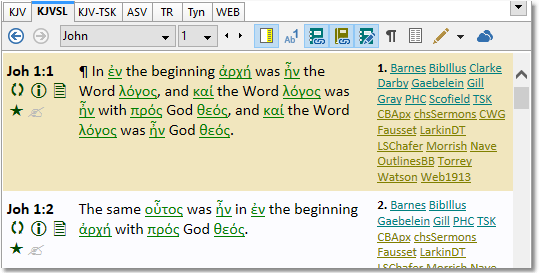
Screen sample: KJVSL in in-line format.
The same settings page also provides an option to display Strong's links as numbers instead of root words:
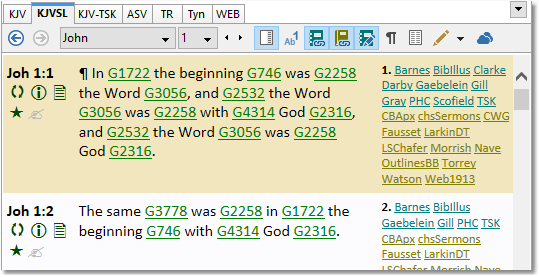
Screen sample: The KJVSL in in-line format with Strong's numbering instead of root word forms.
Searching for Strong's Links/Numbers
You can perform searches in the KJVSL for Strong's Links. Searches are performed like regular searches except that instead of typing a word to search for, you type a G or H followed by the Strong's Number. So to search for other occurrences of the Strong's Link λόγος, you would search for G3056. A G prefixes Greek Strong's numbers, and an H prefixes Hebrew Strong's numbers. You can get the Strong's number for a Strong's Link by simply holding your mouse pointer over the link.
If you right-click on a Strong's link in the Bible panel, the pop-up menu adds a function for searching for that Hebrew or Greek word:
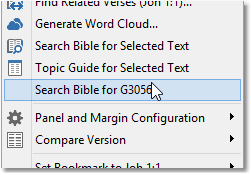
Sample right-click menu for a Strong's link
Clicking Search Bible for G3056 would open the Search Bible dialog with the appropriate search text filled in. You can also type a Strong's number (such as G3056) directly into the Search toolbar (with the KJVSL active) to perform the same search.
You can search the KJV for Strong's numbers as well. If you search the KJV for a Strong's number, the results will show the English words for the Strong's link (see below for example).
Strong's Lexicons (SGreek and SHebrew)
While the lexicon definitions are visible in the pop-ups over the KJVSL links, they are also included in the SGreek and SHebrew book modules. These open when you click a Strong's link.
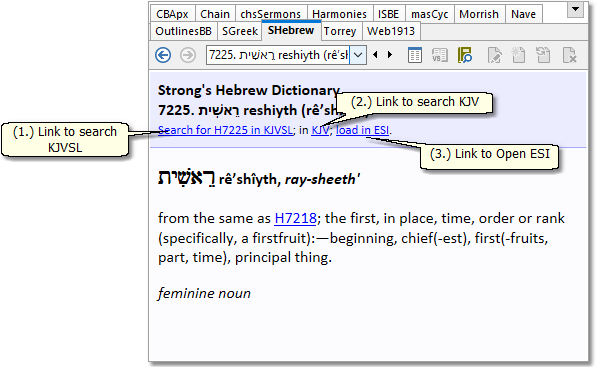
Sample screen: Strong's Hebrew lexicon for H7225.
There are three convenience links for searching for the Strong's number. The first two links load a complete list of all of the verses that contain the Strong's number. The difference between using the (1.) KJVSL and (2.) KJV is in how the verses are displayed. The KJVSL will show the search results in the KJVSL along with Strong's links, while the KJV will only show the English:
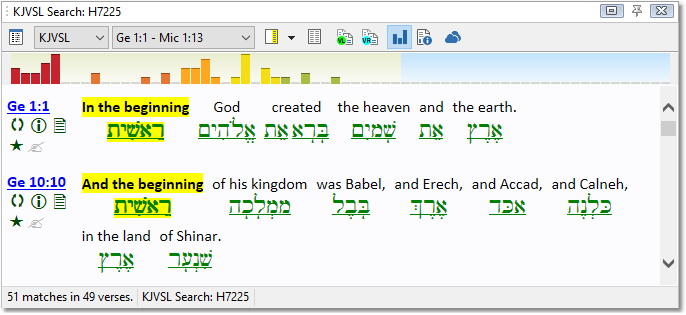
(1.) Sample screen: KJVSL search for H7225, showing reverse interlinear.
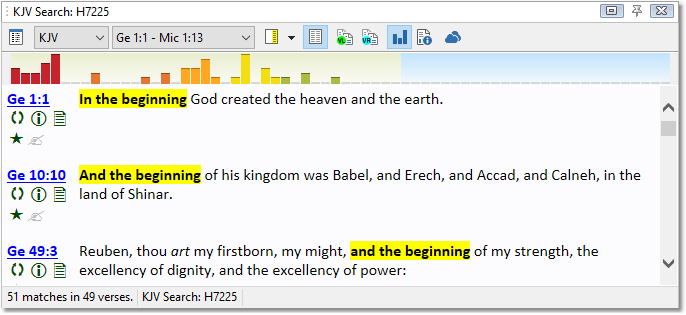
(2.) Sample screen: KJV search for H7225, without interlinear.
Tip: Switch to Concordance View for an easy way to see how the Strong's word is used:
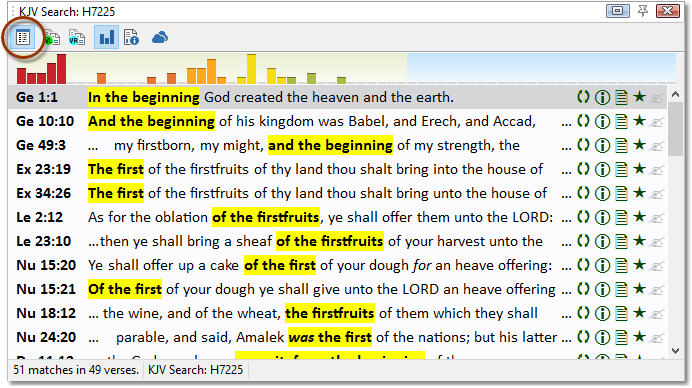
Search for H7225 displayed in Concordance View mode.
Also, click the Search Info and Statistics button (  ) for a list of all of the renderings.
) for a list of all of the renderings.
The third convenience link (3) opens the analytical concordance tool called the English Strong's Indexer (ESI).
Signs employed in the SGreek and SHebrew lexicon entries:
After the punctuation mark :— are given all the different renderings of the word in the Authorized Version.
+ (Addition) denotes a rendering in the A. V. of one or more Greek or Hebrew words in connection with the one under consideration.
× (Multiplication) denotes a rendering in the A. V. that results from an idiom peculiar to the Greek or Hebrew.
( ) (Parenthesis), in the renderings from the A. V., denotes a word of syllable sometimes given in connection with the principle word to which it is annexed.
[ ] (Brackets), in the rendering from the A. V., denotes the inclusion of an additional word in the Greek or Hebrew.
In this digital edition, entry titles include two forms of transliteration of the Greek or Hebrew word; the first easily typed, and the second for pronunciation.
A word of caution about the KJVSL
The KJVSL is not a true interlinear Bible. Not all Strong's Links actually map to the direct Hebrew or Greek word that is found in the original language on a particular verse. This is due to the fact that Strong's Lexicon does not include every form of the Hebrew or Greek words that appeared in the original language texts, but instead groups words by their root form. So while the Strong's Links and lexicon can be useful tools, they are not here to help anyone "re-translate" the Bible. If you need to read the actual Greek or Hebrew text of the Bible, use the Textus Receptus (TR) Bible text. Remember also that Strong's lexicon definitions are glosses, not thorough definitions.